Amblyomma americanum: Difference between revisions
Jump to navigation
Jump to search
Gerald Chi- (talk | contribs) (Created page with "{{Taxobox | name = Lone star tick | regnum = Animalia | phylum = Arthropoda | classis = Arachnida | subclassis = Acari | ordo = Ixodida | familia = ...") |
No edit summary |
||
| (4 intermediate revisions by the same user not shown) | |||
| Line 1: | Line 1: | ||
{{Taxobox | {{Taxobox | ||
| name = Lone star tick | | name = Lone star tick | ||
| image= Amblyomma americanum.jpg | |||
| regnum = [[Animal]]ia | | regnum = [[Animal]]ia | ||
| phylum = [[Arthropod]]a | | phylum = [[Arthropod]]a | ||
| Line 21: | Line 22: | ||
'''''Amblyomma americanum''''', or '''lone star tick''', is a species of [[tick]] in the genus ''[[Amblyomma]]''. | '''''Amblyomma americanum''''', or '''lone star tick''', is a species of [[tick]] in the genus ''[[Amblyomma]]''. | ||
==Distribution== | ==Life Cycle== | ||
It is very widespread in the United States ranging from Texas to Iowa in the Midwest and east to the coast where it can be found as far north as Maine.<ref>{{cite journal |author=James E. Childs & Christopher D. Paddock |title=The ascendancy of ''Amblyomma americanum'' as a vector of pathogens affecting humans in the United States |journal=[[Annual Review of Entomology]] |volume=48 |issue=1 |pages=307–337 |year=2003 |pmid=12414740 |doi=10.1146/annurev.ento.48.091801.112728}}</ref> It is most common in wooded areas, | |||
====General Tick Life Cycle==== | |||
[[Image:Lifecycle.jpg|left|thumb| This image displays an example of the tick lifecycle, based on stages and the months that they are most likely to occur during.]] | |||
*A tick's life cycle is composed of four stages: ''hatching'' (egg), ''nymph'' (six legged), ''nymph'' (eight legged), and an ''adult''. | |||
*Ticks require blood meal to survive through their life cycle. | |||
*Hosts for tick blood meals include mammals, birds, reptiles, and amphibians. Ticks will most likely transfer between different hosts during the different stages of their life cycle. | |||
*Humans are most often targeted during the nymph and adult stages of the life cycle. | |||
*Life cycle is also dependent on seasonal variation. | |||
*Ticks will go from eggs to larva during the summer months, infecting bird or rodent host during the larval stage. | |||
*Larva will infect the host from the summer until the following spring, at which point they will progress into the nymph stage. | |||
*During the nymph stage, a tick will most likely seek a mammal host (including humans). | |||
*A nymph will remain with the selected host until the following fall at which point it will progress into an adult. | |||
*As an adult, a tick will feed on a mammalian host. However unlike previous stages, ticks will prefer larger mammals over rodents. | |||
*The average tick life cycle requires three years for completion. | |||
**Different species will undergo certain variations within their individual life cycles. <ref name="LCT CDC”">Life Cycle of Ticks that Bite Humans (2015). http://www.cdc.gov/ticks/life_cycle_and_hosts.html Accessed on December 30, 2015</ref> | |||
<br> | |||
<br> | |||
<br> | |||
<br> | |||
'''Spread of Tick-borne Disease''' | |||
*Ticks require blood meals in order to progress through their life cycles. | |||
*The average tick requires 10 minutes to 2 hours when preparing a blood meal. | |||
*Once feeding, releases anesthetic properties into its host, via its saliva. | |||
*A feeding tube enters the host followed by an adhesive-like substance, attaching the tick to the host during the blood meal. | |||
*A tick will feed for several days, feeding on the host blood and ingesting the host's pathogens. | |||
*Once feeding is completed, the tick will seek a new host and transfer any pathogens during the next feeding process. <ref name="LCT CDC”">Life Cycle of Ticks that Bite Humans (2015). http://www.cdc.gov/ticks/life_cycle_and_hosts.html Accessed on December 30, 2015</ref>{{Clear}} | |||
==''Amblyomma americanum'' Transmitted Diseases== | |||
* Human monocytotropic ehrlichiosis (''[[Ehrlichia chaffeensis]]'') | |||
* Canine and Human granulocytic ehrlichiosis (''[[Ehrlichia ewingii]]'') | |||
* Tularemia (''[[Francisella tularensis]]'') | |||
* [[southern tick-associated rash illness]] (STARI, possibly caused by the spirochete ''[[Borrelia lonestari]]'').<ref>{{cite journal |author=Edwin J. Masters, Chelsea N. Grigery & Reid W. Masters |title=STARI, or Masters disease: lone star tick-vectored Lyme-like illness |journal=[[Infectious Disease Clinics of North America]] |volume=22 |issue=2 |pages=361–376, viii |date=June 2008 |pmid=18452807 |doi=10.1016/j.idc.2007.12.010}}</ref> STARI exhibits a rash similar to that caused by [[Lyme disease]], but is generally considered to be less severe. | |||
* Though the primary bacterium responsible for Lyme disease, ''[[Borrelia burgdorferi]]'', has occasionally been isolated from lone star ticks, numerous vector competency tests have demonstrated that this tick is extremely unlikely to be capable of transmitting Lyme disease. | |||
* Some evidence indicates ''A. americanum'' saliva inactivates ''B. burgdorferi'' more quickly than the saliva of ''[[Ixodes scapularis]]''.<ref name="pmid15752182">{{cite journal |author=K. E. Ledin, N. S. Zeidner, J. M. C. Ribeiro, B. J. Biggerstaff, M. C. Dolan, G. Dietrich, L. VredEvoe & J. Piesman |title=Borreliacidal activity of saliva of the tick ''Amblyomma americanum'' |journal=[[Medical and Veterinary Entomology]] |volume=19 |issue=1 |pages=90–95 |date=March 2005 |pmid=15752182 |doi=10.1111/j.0269-283X.2005.00546.x |url=http://www.blackwell-synergy.com/openurl?genre=article&sid=nlm:pubmed&issn=0269-283X&date=2005&volume=19&issue=1&spage=90}}</ref> | |||
* Recently the bacteria ''[[Borrelia andersonii]]'' and ''[[Borrelia americana]]'' have been linked to ''Amblyomma americanum''.<ref>{{Cite doi|10.7150/ijms.6273}}</ref> | |||
* In response to two cases of severe febrile illness occurring in two farmers in northwestern Missouri, researchers determined the lone star tick can transmit the [[heartland virus]] in 2013.<ref>{{Cite doi|10.4269/ajtmh.13-0209}}</ref> | |||
* Six more cases were identified in 2012–2013 in Missouri and Tennessee.<ref>http://www.cdc.gov/media/releases/2014/p0327-heartland.html</ref> | |||
==Meat allergy== | |||
<!-- According to research by Drs [[Thomas Platts-Mills]] and Scott Commins published in 2011 -->* The bite of this tick can cause a person to develop a [[meat allergy]] to nonprimate mammalian meat and meat products.<ref>{{cite journal |last=Commins |first=Scott P. |last2=James |first2=Hayley R. |last3=Kelly |first3=Libby A. |last4=Pochan |first4=Shawna L. |last5=Workman |first5=Lisa J. |last6=Perzanowski |first6=Matthew S. |last7=Kocan |first7=Katherine M. |last8=Fahy |first8=John V. |last9=Nganga |first9=Lucy W. |last10=Ronmark |first10=Eva |last11=Cooper |first11=Philip J. |last12=Platts-Mills |first12=Thomas A.E. |date=May 2011 |title=The relevance of tick bites to the production of IgE antibodies to the mammalian oligosaccharide galactose-α-1,3-galactose |url=http://www.jacionline.org/article/S0091-6749%2811%2900344-7/abstract |journal=The Journal of Allergy and Clinical Immunology |volume=127 |issue=5 |pages=1286-1293 |doi=10.1016/j.jaci.2011.02.019 |accessdate=20 May 2014 |pmid=21453959 |pmc=3085643}}</ref> | |||
* This allergy is characterized by adult onset, and a delayed reaction of [[urticaria]] or [[anaphylaxis]] appearing 4–8 hours after consumption of the allergen. | |||
* The allergen has been identified as a carbohydrate called [[galactose-α-1,3-galactose]] (alpha gal). | |||
* As well as occurring in nonprimate mammals, alpha gal is also found in cat dander and a drug used to treat head and neck cancer. | |||
* Commercial tests for alpha gal IgE became available following research. | |||
==Geographic Distribution== | |||
*It is very widespread in the United States ranging from Texas to Iowa in the Midwest and east to the coast; where it can be found as far north as Maine.<ref>{{cite journal |author=James E. Childs & Christopher D. Paddock |title=The ascendancy of ''Amblyomma americanum'' as a vector of pathogens affecting humans in the United States |journal=[[Annual Review of Entomology]] |volume=48 |issue=1 |pages=307–337 |year=2003 |pmid=12414740 |doi=10.1146/annurev.ento.48.091801.112728}}</ref> | |||
*It is most common in wooded areas, paricularly in forests with thick underbrush, and large trees. | |||
{{Clear left}} | {{Clear left}} | ||
[[Image:Lone star tick.jpg|center|500px]] | |||
== | ==Prevention== | ||
===Limiting tick exposure=== | |||
[[Image:SOCKS.jpg|left|thumb|180px|Tuck pants into socks]] | |||
It is unreasonable to assume that a person can completely eliminate activities that may result in tick exposure. Therefore, prevention measures should emphasize personal protection when exposed to natural areas where ticks are present: | |||
*Wear light-colored clothing which allows you to see ticks that are crawling on your clothing. | |||
*Tuck your pants legs into your socks so that ticks cannot crawl up the inside of your pants legs. | |||
*Apply repellents to discourage tick attachment. Repellents containing [[permethrin]] can be sprayed on boots and clothing, and will last for several days. Repellents containing [[DEET]] (n, n-diethyl-m-toluamide) can be applied to the skin, but will last only a few hours before reapplication is necessary. Use DEET with caution on children. Application of large amounts of DEET on children has been associated with adverse reactions. | |||
*Conduct a body check upon return from potentially tick-infested areas by searching your entire body for ticks. Use a hand-held or full-length mirror to view all parts of your body. Remove any tick you find on your body. | |||
*Parents should check their children for ticks, especially in the [[hair]], when returning from potentially tick-infested areas. | |||
*Ticks may also be carried into the household on clothing and pets and only attach later, so both should be examined carefully to exclude ticks.<ref name="GenTickDis CDC”">General Tick Disease Information. Centers for Disease Control and Prevention (2015). http://www.cdc.gov/ticks/symptoms.html Accessed on December 30, 2015</ref> | |||
<br> | |||
===The best way to remove a tick=== | |||
#Use fine-tipped tweezers or notched tick extractor, and protect your fingers with a tissue, paper towel, or latex gloves. Persons should avoid removing ticks with bare hands. | |||
#Grasp the tick as close to the skin surface as possible and pull upward with steady, even pressure. Do not twist or jerk the tick; this may cause the mouth-parts to break off and remain in the skin. (If this happens, remove mouth-parts with tweezers. Consult your health care provider if illness occurs.) | |||
#After removing the tick, thoroughly disinfect the bite site and wash your hands with soap and water. | |||
[[Image:Tick removal process.jpg|250px|center|thumb|Tick removal process]] | |||
*Do not squeeze, crush, or puncture the body of the tick because its fluids may contain infectious organisms. Skin accidentally exposed to tick fluids can be disinfected with iodine scrub, rubbing alcohol, or water containing detergents. | |||
[[Image:Removal.jpg|250px|center|thumb|Removal of an embedded tick using fine-tipped tweezers]] | |||
*Save the tick for identification in case you become ill. This may help your doctor to make an accurate diagnosis. Place the tick in a sealable plastic bag and put it in your freezer. Write the date of the bite on a piece of paper with a pencil and place it in the bag. <ref name="Tick Removal CDC”">Tick Removal. Centers for Disease Control and Prevention (2015). http://www.cdc.gov/ticks/removing_a_tick.html Accessed on December 30, 2015</ref> | |||
==References== | ==References== | ||
| Line 57: | Line 116: | ||
* Disease transmitted: [[ehrlichiosis]], [[tularemia]], [[southern tick-associated rash illness]] | * Disease transmitted: [[ehrlichiosis]], [[tularemia]], [[southern tick-associated rash illness]] | ||
<gallery widths=350px> | <gallery widths="350px"> | ||
Amblyomma americanum.jpg | Lone star tick (''Amblyomma americanum'') <br> [http://www.cdc.gov/ticks/geographic_distribution.html <font size="-2">''Adapted from CDC''</font>] | Amblyomma americanum.jpg | Lone star tick (''Amblyomma americanum'') <br> [http://www.cdc.gov/ticks/geographic_distribution.html <font size="-2">''Adapted from CDC''</font>] | ||
Latest revision as of 17:49, 17 February 2016
| style="background:#Template:Taxobox colour;"|Lone star tick | ||||||||||||||||
|---|---|---|---|---|---|---|---|---|---|---|---|---|---|---|---|---|
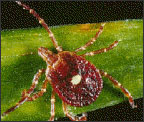 | ||||||||||||||||
| style="background:#Template:Taxobox colour;" | Scientific classification | ||||||||||||||||
| ||||||||||||||||
| Binomial name | ||||||||||||||||
| Amblyomma americanum (Linnaeus, 1758) [1] | ||||||||||||||||
| Red indicates where the species is normally found; Blue indicates other locations where the species has been reported Red indicates where the species is normally found; Blue indicates other locations where the species has been reported
|
Editor-In-Chief: C. Michael Gibson, M.S., M.D. [1]
Overview
Amblyomma americanum, or lone star tick, is a species of tick in the genus Amblyomma.
Life Cycle
General Tick Life Cycle
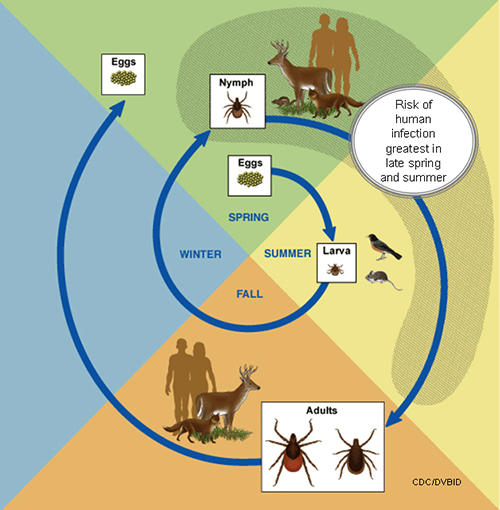
- A tick's life cycle is composed of four stages: hatching (egg), nymph (six legged), nymph (eight legged), and an adult.
- Ticks require blood meal to survive through their life cycle.
- Hosts for tick blood meals include mammals, birds, reptiles, and amphibians. Ticks will most likely transfer between different hosts during the different stages of their life cycle.
- Humans are most often targeted during the nymph and adult stages of the life cycle.
- Life cycle is also dependent on seasonal variation.
- Ticks will go from eggs to larva during the summer months, infecting bird or rodent host during the larval stage.
- Larva will infect the host from the summer until the following spring, at which point they will progress into the nymph stage.
- During the nymph stage, a tick will most likely seek a mammal host (including humans).
- A nymph will remain with the selected host until the following fall at which point it will progress into an adult.
- As an adult, a tick will feed on a mammalian host. However unlike previous stages, ticks will prefer larger mammals over rodents.
- The average tick life cycle requires three years for completion.
- Different species will undergo certain variations within their individual life cycles. [2]
Spread of Tick-borne Disease
- Ticks require blood meals in order to progress through their life cycles.
- The average tick requires 10 minutes to 2 hours when preparing a blood meal.
- Once feeding, releases anesthetic properties into its host, via its saliva.
- A feeding tube enters the host followed by an adhesive-like substance, attaching the tick to the host during the blood meal.
- A tick will feed for several days, feeding on the host blood and ingesting the host's pathogens.
- Once feeding is completed, the tick will seek a new host and transfer any pathogens during the next feeding process. [2]
Amblyomma americanum Transmitted Diseases
- Human monocytotropic ehrlichiosis (Ehrlichia chaffeensis)
- Canine and Human granulocytic ehrlichiosis (Ehrlichia ewingii)
- Tularemia (Francisella tularensis)
- southern tick-associated rash illness (STARI, possibly caused by the spirochete Borrelia lonestari).[3] STARI exhibits a rash similar to that caused by Lyme disease, but is generally considered to be less severe.
- Though the primary bacterium responsible for Lyme disease, Borrelia burgdorferi, has occasionally been isolated from lone star ticks, numerous vector competency tests have demonstrated that this tick is extremely unlikely to be capable of transmitting Lyme disease.
- Some evidence indicates A. americanum saliva inactivates B. burgdorferi more quickly than the saliva of Ixodes scapularis.[4]
- Recently the bacteria Borrelia andersonii and Borrelia americana have been linked to Amblyomma americanum.[5]
- In response to two cases of severe febrile illness occurring in two farmers in northwestern Missouri, researchers determined the lone star tick can transmit the heartland virus in 2013.[6]
- Six more cases were identified in 2012–2013 in Missouri and Tennessee.[7]
Meat allergy
- The bite of this tick can cause a person to develop a meat allergy to nonprimate mammalian meat and meat products.[8]
- This allergy is characterized by adult onset, and a delayed reaction of urticaria or anaphylaxis appearing 4–8 hours after consumption of the allergen.
- The allergen has been identified as a carbohydrate called galactose-α-1,3-galactose (alpha gal).
- As well as occurring in nonprimate mammals, alpha gal is also found in cat dander and a drug used to treat head and neck cancer.
- Commercial tests for alpha gal IgE became available following research.
Geographic Distribution
- It is very widespread in the United States ranging from Texas to Iowa in the Midwest and east to the coast; where it can be found as far north as Maine.[9]
- It is most common in wooded areas, paricularly in forests with thick underbrush, and large trees.
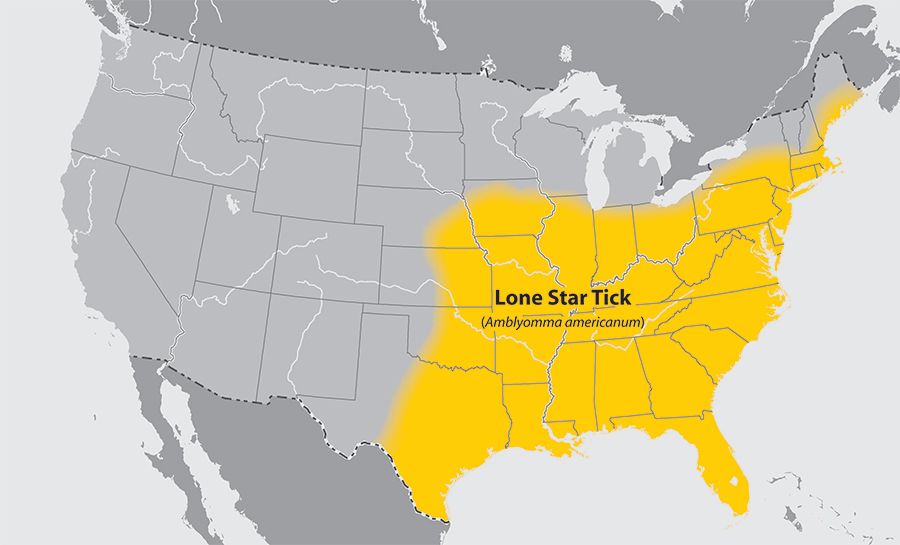
Prevention
Limiting tick exposure
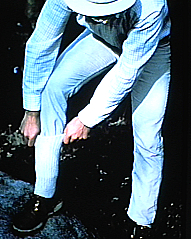
It is unreasonable to assume that a person can completely eliminate activities that may result in tick exposure. Therefore, prevention measures should emphasize personal protection when exposed to natural areas where ticks are present:
- Wear light-colored clothing which allows you to see ticks that are crawling on your clothing.
- Tuck your pants legs into your socks so that ticks cannot crawl up the inside of your pants legs.
- Apply repellents to discourage tick attachment. Repellents containing permethrin can be sprayed on boots and clothing, and will last for several days. Repellents containing DEET (n, n-diethyl-m-toluamide) can be applied to the skin, but will last only a few hours before reapplication is necessary. Use DEET with caution on children. Application of large amounts of DEET on children has been associated with adverse reactions.
- Conduct a body check upon return from potentially tick-infested areas by searching your entire body for ticks. Use a hand-held or full-length mirror to view all parts of your body. Remove any tick you find on your body.
- Parents should check their children for ticks, especially in the hair, when returning from potentially tick-infested areas.
- Ticks may also be carried into the household on clothing and pets and only attach later, so both should be examined carefully to exclude ticks.[10]
The best way to remove a tick
- Use fine-tipped tweezers or notched tick extractor, and protect your fingers with a tissue, paper towel, or latex gloves. Persons should avoid removing ticks with bare hands.
- Grasp the tick as close to the skin surface as possible and pull upward with steady, even pressure. Do not twist or jerk the tick; this may cause the mouth-parts to break off and remain in the skin. (If this happens, remove mouth-parts with tweezers. Consult your health care provider if illness occurs.)
- After removing the tick, thoroughly disinfect the bite site and wash your hands with soap and water.

- Do not squeeze, crush, or puncture the body of the tick because its fluids may contain infectious organisms. Skin accidentally exposed to tick fluids can be disinfected with iodine scrub, rubbing alcohol, or water containing detergents.
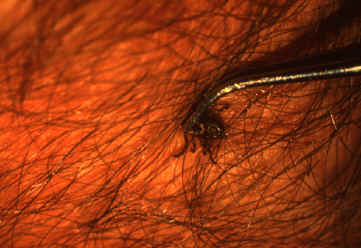
- Save the tick for identification in case you become ill. This may help your doctor to make an accurate diagnosis. Place the tick in a sealable plastic bag and put it in your freezer. Write the date of the bite on a piece of paper with a pencil and place it in the bag. [11]
References
- ↑ Template:EOL
- ↑ 2.0 2.1 Life Cycle of Ticks that Bite Humans (2015). http://www.cdc.gov/ticks/life_cycle_and_hosts.html Accessed on December 30, 2015
- ↑ Edwin J. Masters, Chelsea N. Grigery & Reid W. Masters (June 2008). "STARI, or Masters disease: lone star tick-vectored Lyme-like illness". Infectious Disease Clinics of North America. 22 (2): 361–376, viii. doi:10.1016/j.idc.2007.12.010. PMID 18452807.
- ↑ K. E. Ledin, N. S. Zeidner, J. M. C. Ribeiro, B. J. Biggerstaff, M. C. Dolan, G. Dietrich, L. VredEvoe & J. Piesman (March 2005). "Borreliacidal activity of saliva of the tick Amblyomma americanum". Medical and Veterinary Entomology. 19 (1): 90–95. doi:10.1111/j.0269-283X.2005.00546.x. PMID 15752182.
- ↑ Template:Cite doi
- ↑ Template:Cite doi
- ↑ http://www.cdc.gov/media/releases/2014/p0327-heartland.html
- ↑ Commins, Scott P.; James, Hayley R.; Kelly, Libby A.; Pochan, Shawna L.; Workman, Lisa J.; Perzanowski, Matthew S.; Kocan, Katherine M.; Fahy, John V.; Nganga, Lucy W.; Ronmark, Eva; Cooper, Philip J.; Platts-Mills, Thomas A.E. (May 2011). "The relevance of tick bites to the production of IgE antibodies to the mammalian oligosaccharide galactose-α-1,3-galactose". The Journal of Allergy and Clinical Immunology. 127 (5): 1286–1293. doi:10.1016/j.jaci.2011.02.019. PMC 3085643. PMID 21453959. Retrieved 20 May 2014.
- ↑ James E. Childs & Christopher D. Paddock (2003). "The ascendancy of Amblyomma americanum as a vector of pathogens affecting humans in the United States". Annual Review of Entomology. 48 (1): 307–337. doi:10.1146/annurev.ento.48.091801.112728. PMID 12414740.
- ↑ General Tick Disease Information. Centers for Disease Control and Prevention (2015). http://www.cdc.gov/ticks/symptoms.html Accessed on December 30, 2015
- ↑ Tick Removal. Centers for Disease Control and Prevention (2015). http://www.cdc.gov/ticks/removing_a_tick.html Accessed on December 30, 2015
External links
Gallery
- Common name: lone star tick
- Scientific name: Amblyomma americanum
- Reservoir: birds and deer (larvae and nymphs); white-tailed deer (adult ticks)
- Geographic distribution: southeastern and eastern United States
- Disease transmitted: ehrlichiosis, tularemia, southern tick-associated rash illness
-
Lone star tick (Amblyomma americanum)
Adapted from CDC -
Approximate distribution of the lone star tick
Adapted from CDC